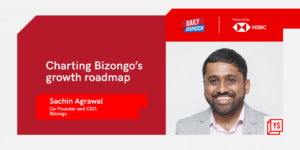The recent popularity of design thinking may lead one to believe that it’s a great technique for all kinds of problem-solving. However, after having conducted over 450 workshops with more than 100 corporates and startups in India and abroad, I would be the first one to call out that design thinking is not a tool for every season and every reason.
There are certain contexts that suit this approach better than others and one must be diligent in designing a problem worth addressed by this said approach. In this piece, I identify five attributes of a context that suits this systematic model of problem solving and offer tips from my consulting and practice experience on how one could benefit from this approach.
Design your thinking
Let’s start with a working definition of design thinking. Much beyond the realm of product design or industrial design, design thinking is essentially a human-centric systematic approach to problem-solving. The three keywords are: human-centric, systematic, and problem-solving.
The approach differs from the traditional models of creativity by putting human right at the centre of the pursuit and offers a method to the otherwise haphazard approach to ideation. It is about problem-solving and not designing. So much so that the method helps you Design Your Thinking.
There are five qualifiers of contexts best suited for the approach: audacity of goal, the ambiguity of context, availability of time, access to customer, and diversity of team. Let’s delve deeper into these.
Audacity of goal
The starting point of design thinking is not an idea or even a problem; instead, it’s an inspiration. A desire to deliver a superlative experience to the customer, as is the case with Bigbasket. Or to address a vexing problem, as was the case with Paytm Soundbox. Since the approach is heavily front-loaded, in terms of its emphasis on divergent thinking and situating oneself in the native context, it’s best adopted to address a stretch goal than something that is achievable by workarounds or efficiency gains.
If I am a shopfloor supervisor and I wish to increase the assembly line productivity by 5% or lower absenteeism by 2%, design thinking isn’t advisable. However, if I want to make my assembly line entirely autonomous and yet not lose any employees in the process, then design thinking is the way to go. The approach is best suited when you are seeking a multiplier effect instead of productivity gains.
The best of design thinking projects start with the leaders setting up a BHAG (big hairy audacious goal) and then letting the team reign in controlled chaos. Think of the XUV500 project, where Anand Mahindra set the team on a course of designing ‘a world-class SUV for the value-conscious Indians’. That’s an audacious goal.
Ambiguity of context
There are several methods of creative problem-solving. You have the Russian TRIZ (Theory of Inventive Problem Solving), Lateral Thinking, Six Thinking Hats, Value Innovation Tools from Blue Ocean Strategy, SCAMPER, and Mind Mapping, among others. However, design thinking has its premium when you are confronted with an unclear situation—a context where the problem is ill-defined, with several stakeholders having conflicting interests, in a rapidly changing backdrop. Think in terms of solving the ongoing Ukraine-Russia conflict or getting the Sri Lankan economy back on track. These are multi-dimensional problems, true to the archetype of the VUCA (volatile, uncertain, complex, and ambiguous) world. Under such realms, design thinking can be extremely fertile.
Design thinking, through its stages of Inspire, Empathise and Define, Ideate, Prototype and Test, and Scale, offers an iterative, flexible, and nimble approach, which is best suited to a rapidly evolving context. With its significant investment on empathising with the stakeholders and deferring judgement, design thinking allows information to flow in from multiple dimensions, and by not attempting to rule out an option early on, it becomes easier to factor in newer developments along the course. No one gets surprised if some of the initial assumptions turn out to be sour, for the approach is built on the very premise of continuous discovery.
Availability of time
Should you use design thinking to solve urgent problem? Perhaps not. You would rather use common sense, hit-and-trial, intuition, or some form of improvisation to address the urgent matter at hand and not invoke this time-consuming approach called design thinking.
The elaborate nature of design thinking is both its strength and weakness—depending on the context. I would rather not be using design thinking when both the engines are down and I am attempting to land my Airbus A320 on the Hudson River off Midtown Manhattan. I would rather use my judgement bearing on all my past flying experience and do a bit of mental simulation in the scarce time I have with me.
Since design thinking necessitates you to engage in divergent thinking, where you consider multiple explanations of the phenomenon before zeroing in on the most probable ones and entertain scores of possible resolutions before settling with the most viable ones, one can’t rush through the stages.
As it turns out, only when you have spent sufficient time investigating the problem and considered all possible facets of it a new insight would emerge. Design thinking must entertain false starts, dead ends, about turns, and killing of darlings before a few promising ideas emerge. So, you need time.
Access to customer
One of the central tenets of design thinking is human centricity. It’s often confused with ‘customer centricity’ and a customer is often confused with the one who’s paying for your products. That’s a self-defeating and narrow definition. Think of the customer as anybody whose problem you wish to solve and hence, human centricity broadly translates into empathy for all. Though it’s ‘bounded empathy’, where your concern for other humans is governed by what’s technically feasible and commercially viable.
Access to the customer is the key to problem-solving, for you are not solving a problem for the customer, but with the customer. The aim of design thinking is to take away the guesswork from the innovation or the problem-solving equation.
No longer could it be said that the customer knows the problem and the seller knows the means to solving it; rather the approach is to co-discover the problem before co-creating the solution. This necessitates that the customer is by the side, if not a part, of the problem discovery and solutions. This helps keep the effort purposeful and less wasteful and can lead to course correction through rapid iteration. However, the customer must be incentivised appropriately to bring forth the real problem or the desire and be ready to try out new ideas.
Diversity of team
Finally, the confluence of multiple perspectives that it takes to solve a wicked problem. The outcome of a problem-solving exercise is only as good as the raw material and the process. While design thinking takes care of the process, the raw material must be curated in a more conscious manner.
Expert problem solvers seek diversity. A variety, not only in the dimensions of age, gender, educational background, and ethnicity, but in also the more invisible types, such as introversion versus extraversion, visual versus kinaesthetic thinkers, or even with respect to risk-taking propensity. The most successful problem-solving and innovation teams actively seek diversity not only from within the organisation but also from its ecosystem.
I remember facilitating a two-day design thinking workshop for Marico, the makers of Parachute coconut hair oil. Among the participants were folks from manufacturing, supply chain, and marketing, those from the CSR arm of the company, and even coconut farmers and their children. In a similar workshop at Biocon, apart from representatives from all functional areas of the company, we had doctors, folks from NGOs focused on cancer care, startup founders offering last-mile healthcare, government officials, and leaders from partner organisations. In fact, the quantity and quality of ideas is directly proportional to the variety of participants.
In summary, design thinking is a useful approach provided you adopt it for a situation that does justice to the effort that the approach demands. In most corporates, just about 10-20% of problems demand this level of investment and, in most successful attempts, the leaders show personal commitment. Hope you find this piece insightful and hope it helps you craft your next problem-solving expedition on design thinking.
(Disclaimer: The views and opinions expressed in this article are those of the author and do not necessarily reflect the views of YourStory.)










